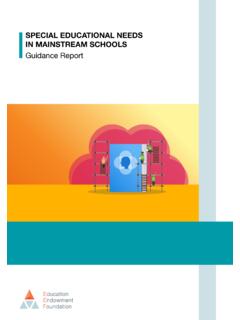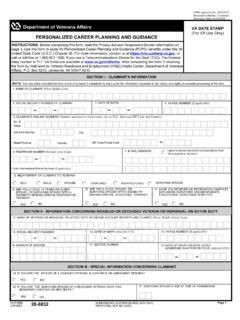Transcription of Special educational needs and disability: an analysis and ...
1 Special educational needs and disability : an analysis and summary of data sources June 2022 2 Contents Introduction 3 Prevalence and characteristics 6 Key trends 6 Type of need 7 Characteristics 7 Types of school 8 Early years 9 Looked after children and children in need with SEN prevalence and characteristics 10 Outcomes 11 Early Years Foundation Stage Profile (EYFSP) 11 Phonics screening check 11 Key Stage 1 11 Key Stage 2 11 Key Stage 4 12 Post-16 attainment by age 19 12 Absence, exclusions and suspensions 12 Preparation for Adulthood 13 Post-16 learner participation 13 Destinations 13 Progression to higher education 13 Employment status for adults with learning disabilities receiving support from social services 14 Housing status for adults with learning disabilities receiving support from social services 14 Experience of the SEND system 15 Timeliness of issuing statements and EHC plans 15 Appeals registered with the SEND tribunal 16 disability 18 Related information 19 Local Authority Interactive Tool (LAIT)
2 19 LG Inform 19 Ofsted/ CQC inspections 19 3 Introduction This document provides a combination of analysis and links to the key data sources on children and young people with Special educational needs and / or a disability (SEND). This is the ninth release in this format1 and follows on from the initial publication in November 2015. The table below lists the topics included in this publication with a link to the source data and whether time series and local authority (LA) level data is available. Commentary on the data trends and more detailed analysis can be found by clicking on the link in the publication title column. This is a collated product from data published throughout the year.
3 As such, trends across sections might not be directly comparable. More detail can be found in the text. You may also wish to use this publication alongside benchmarking data tools, such as the Local Authority Interactive Tool ( LAIT) and LG Inform. Further details are provided on page 19. Topic Publication title link Latest data reference point Time series data available? LA level data by SEN available? When next published and how often updated Prevalence and characteristics Special educational needs in England: January 2022 January 2022 Yes Yes June 2023, annual Early years SEN prevalence Education provision: children under 5 years of age, January 2021 January 2021 Yes Yes June 2022, annual Early years Foundation Stage profile (EYFSP) Early years foundation stage profile results: 2018 to 2019 2018/19 (academic year) Yes Yes November 2022, annual Phonics screening check and Key Stage 1 attainment Phonics screening check and key stage 1 assessments.
4 England 2019 2018/19 Yes Yes Between September and October 2022, annual 1 There were two updates to this document in 2016. 4 Topic Publication title link Latest data reference point Time series data available? LA level data by SEN available? When next published and how often updated Key Stage 2 attainment Key stage 2 performance, 2019 (revised) 2018/19 Yes Yes September 2022 (provisional), December 2022 (revised), annual Key Stage 4 attainment Key stage 4 performance 2021 2020/21 Yes Yes October 2022, annual Attainment by age 19 Level 2 and 3 attainment by young people aged 16 to 25 in 2021 2020/21 Yes Yes April 2023, annual Outcomes for looked after children and children in need Outcomes for children in need, including children looked after by local authorities, in England 2020/21 Yes Yes March 2023, annual Post-16 participation NEET and participation.
5 Local authority figures March 2021 Yes Yes Summer 2022 Further Education learning difficulty and disability numbers Further education and skills: November 2021 2020/21 Yes No November 2022, annual Destinations measures Destinations of key stage 4 and 5 students: 2020 2019/20 Yes Yes October 2022 , annual Progression into higher education Widening participation in higher education: 2021 2019/20 Yes No July 2022, annual 5 Topic Publication title link Latest data reference point Time series data available? LA level data by SEN available? When next published and how often updated Measures from Adult Social Care Outcomes framework Measures from the Adult Social Care Outcomes Framework, England - 2020-21 2020-21 (financial year) Yes No, CCG level data available October 2022 , annual Absence (full year release) Pupil absence in schools in England' 2020/21 Yes Yes March 2023, annual Permanent exclusions and suspensions Permanent exclusions and suspensions in England.
6 2019 to 2020 2019/20 Yes Yes July 2022, annual Statements and EHC plans numbers, transfers and timeliness of issuing Education, health and care plans January 2022 Yes Yes May 2023, annual Appeals registered with the SEND tribunal Tribunals statistics January March 2022 Yes Yes September 2022, quarterly Family Resources Survey ( disability data) Family Resources Survey 2020-21 2020-21 Yes No March 2023, annual 6 Prevalence and characteristics Key trends The number of pupils with Special educational needs (SEN) increased to million pupils in 2022, representing of all pupils. The proportion of pupils with SEN had been decreasing since 2010 ( ), however it has increased for the last 5 years.
7 The proportion of pupils with a statement of SEN/ Education, Health and Care (EHC) plan increased to in 2022, continuing a trend of increases since 2017. Prior to this, the rate had remained steady at Pupils with an EHC plan made up 24% of all pupils with SEN in January 2022. The number of pupils with an EHC plan has increased by 9% between 2021 and 2022, and by a total of 50% since 2016. Pupils with SEN are currently classified as follows: SEN support: Extra or different help is given from that provided as part of the school s usual curriculum. The class teacher and SEN Coordinator (SENCO) may receive advice or support from outside specialists. The pupil does not have an education, health and care plan.
8 SEN support replaced the former School Action and School Action Plus categories from 2015. Education, Health and Care (EHC) plan: A pupil has an EHC plan when a formal assessment has been made. A document is in place that sets out the child s need and the extra help they should receive. Prior to September 2014, a statement of SEN was used. The period for local authorities to transfer children and young people with statements of SEN to EHC plans started in September 2014 and ended in 2018. Following the introduction of EHC plans in September 2014, statements of SEN and EHC plans were grouped together within the data. 0%5%10%15%20%25%200720082009201020112012 2013201420152016201720182019202020212022 All SEN: ( million pupils)SEN support: ( )SENwith a statement or EHC plan: (355,600 pupils)Percentage ofpupils with SEN in England (as at January each year)Source: School Census7 Type of need In January 2022, for pupils with EHC plans, Autistic Spectrum Disorder was the most common primary type of need, with 103,400 ( ) pupils with EHC plans having this recorded as their primary type of need.
9 For pupils on SEN support, Speech, language and communication needs was the most common type of need, with 262,400 ( ) pupils on SEN support having this recorded as their primary type of need. Characteristics Gender Special educational needs remain more prevalent in boys than girls. In January 2022, of boys received SEN support compared to of girls, and of boys had an EHC plan compared to of girls. Free school meal eligibility Pupils with Special educational needs are more likely to be eligible for free school meals. of pupils with Special educational needs were eligible for free school meals in January 2022 compared to of pupils without Special educational needs .
10 Sensory ImpairmentProfound & Multiple Learning DifficultyVisual ImpairmentHearing ImpairmentSevere Learning DifficultyPhysical DisabilitySEN support but no specialist assessment of type of needOther Difficulty/DisabilitySpecific Learning DifficultyAutistic Spectrum DisorderModerate Learning DifficultySocial, Emotional and Mental HealthSpeech, Language and Communications needsEHC planSEN supportPercentageof pupils by primary type of need and SEN provision, January 2022 Source: School Census8 Ethnicity Travellers of Irish heritage and Black Caribbean pupils had the highest percentage of pupils with an EHC plan in January 2022 ( and respectively). Chinese pupils had the lowest percentage of pupils with an EHC plan in January 2022 at English as a first language Of the pupils whose first language is known to be, or believed to be English, in January 2022, had an EHC plan and received SEN support.















